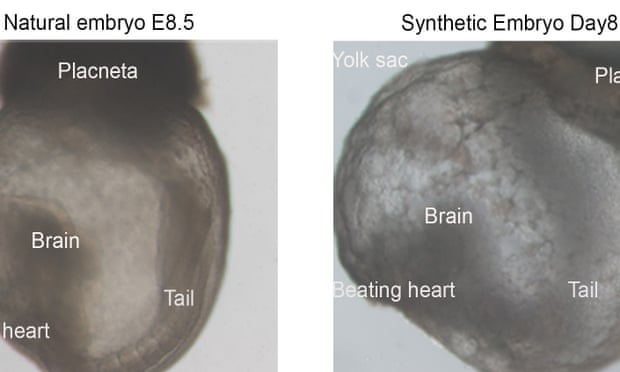The world’s first lab-grown synthetic embryo.
There are two articles about this subject in this singular posting.
The World’s First-Ever “Synthetic Embryo” Is Already Causing Controversy (Video)
August 5, 2022
By Noor Al-Sibai
Reprinted from Futurism
Scientists have created the world’s first lab-grown “synthetic embryo,” a groundbreaking moment in science that has reignited a fierce ethical debate.
Led by molecular geneticist Joseph Hanna, a team of researchers at Israel’s Wizemann Institute of Science managed to create a synthetic mouse “embryo” in a lab without fertilized eggs or a uterus, potentially allowing us to get a glimpse of what happens in the early stages of human pregnancy as well.
This new embryo model, as detailed in the team’s paper published this week in the journal Cell, was able to mimic all the makings of an early body, “including precursors of heart, blood, brain and other organs” as well as “the ‘support’ cells like those found in the placenta and other tissues required to establish and maintain a pregnancy,” as University of Melbourne stem cell researcher Megan Munsie, who was not involved in the research, wrote in a piece for The Conversation.
The research could have major implications.
“This is a crucial stage: in humans, many pregnancies are lost around this stage, and we don’t really know why,” Munsie wrote. “Having models provides a way to better understand what can go wrong, and possibly insights into what we may be able to do about it.”
The embryo model, however, only survived eight out of the 20-day mouse embryonic cycle, a critical drawback that, given the stated goal of Renewal Bio, the company founded by Hanna to commercially fund this research.
The startup’s goal is to develop synthetic human stem cells in an attempt to “solve” human health crises, a science which experts say won’t be ready for decades.
In short, Bio Renewal wants to create embryo-stage versions of humans so that it can harvest tissues for transplants.
Critics who spoke with MIT Technology Review said that it wasn’t time to talk about the creation of synthetic human embryos, especially given the greater political context and controversy surrounding the research.
“It’s absolutely not necessary,” Nicolas Rivron, a stem-cell scientist at Vienna’s Institute of Molecular Biotechnology, told the magazine, “so why would you do it?”
He’s not alone in his criticisms, either.
“Synthetic human embryos are not an immediate prospect,” James Briscoe of the Francis Crick Institute in London told The Guardian in response to the new research.
“We know less about human embryos than mouse embryos and the inefficiency of the mouse synthetic embryos suggests that translating the findings to human requires further development,” he added.
It seems that regardless of where researchers fall on the topic, most agree that it’s way too early to start seriously talking about the ethics of synthetic human embryos — but it’s a breakthrough nonetheless.
READ MORE: This startup wants to copy you into an embryo for organ harvesting [MIT Technology Review]
The post The World’s First-Ever “Synthetic Embryo” Is Already Causing Controversy appeared first on Futurism.
Scientists create world’s first ‘synthetic embryos’
Researchers use stem cells from mice to form embryo-like structures with intestinal tract, beginnings of a brain, and a beating heart
Wednesday, August 3, 2022
By Ian Sample / Science editor
Reprinted from The Guardian [U.K.]

A natural embryo (left) compared with a synthetic embryo. Synthetic embryos are expected to drive deeper understanding of how organs and tissues form during the development of natural embryos. Photograph: Weizmann Institute
Researchers have created the world’s first “synthetic embryos” in a groundbreaking feat that bypassed the need for sperm, eggs and fertilisation.
Scientists at the Weizmann Institute in Israel found that stem cells from mice could be made to self-assemble into early embryo-like structures with an intestinal tract, the beginnings of a brain, and a beating heart.
Known as synthetic embryos because they are created without fertilised eggs, the living structures are expected, in the near term, to drive deeper understanding of how organs and tissues form during the development of natural embryos.
But researchers believe the work could also reduce animal experimentation and ultimately pave the way for new sources of cells and tissues for human transplantation. For example, skin cells from a leukaemia patient could potentially be transformed into bone marrow stem cells to treat their condition.
“Remarkably, we show that embryonic stem cells generate whole synthetic embryos, meaning this includes the placenta and yolk sac surrounding the embryo,” said Prof Jacob Hanna, who led the effort. “We are truly excited about this work and its implications.” The work is published in Cell.
Last year, the same team described how they had built a mechanical womb that enabled natural mouse embryos to grow outside the uterus for several days. In the latest work, the same device was used to nurture mouse stem cells for more than a week, nearly half the gestation time for a mouse.
Some of the cells were pre-treated with chemicals, which switched on genetic programmes to develop into placenta or yolk sac, while others developed without intervention into organs and other tissues.
While most of the stem cells failed to form embryo-like structures, about 0.5% combined into little balls that grew distinct tissues and organs. When compared with natural mouse embryos, the synthetic embryos were 95% the same in terms of their internal structure and the genetic profiles of the cells. As far as the scientists could tell, the organs that formed were functional.
Hanna said synthetic embryos were not “real” embryos and did not have the potential to develop into live animals, or at least they hadn’t when they had been transplanted into the wombs of female mice. He has founded a company called Renewal Bio that aims to grow human synthetic embryos to provide tissues and cells for medical conditions.
“In Israel and many other countries, such as the U.S. and the U.K., it is legal and we have ethical approval to do this with human-induced pluripotent stem cells. This is providing an ethical and technical alternative to the use of embryos,” Hanna said.
Dr. James Briscoe, a principal group leader at the Francis Crick Institute in London, who was not involved in the research, said it was important to discuss how best to regulate the work before human synthetic embryos were developed.
“Synthetic human embryos are not an immediate prospect. We know less about human embryos than mouse embryos and the inefficiency of the mouse synthetic embryos suggests that translating the findings to human requires further development,” Briscoe said.
But, he added: “Now is a good time to consider the best legal and ethical framework to regulate research and use of human synthetic embryos and to update the current regulations.”
Speaking to StatNews, Prof Paul Tesar, a geneticist at Case Western Reserve University, said the more scientists pushed stem cell-derived embryos further and further along the path of development, the more the synthetic and natural embryos begin to merge.
“There will always be a grey area,” he said. “But as scientists and as a society we need to come together to decide where the line is and define what is ethically acceptable.”
The creation of “synthetic” human embryos is outside of the legal framework of the U.K.’s Human Fertilisation and Embryology Act, but it would be unlawful to use them to establish a pregnancy in a woman, because they are not classed as “permitted embryos”.







Leave a Reply, please --- thank you.